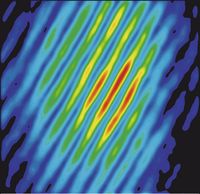Direct Frequency Comb Spectroscopy
Beyond optical clocks – Frequency comb as versatile spectroscopic tool

- Dual comb spectroscopy
- Cavity enhanced comb spectroscopy
- Mid-IR comb spectroscopy
- Coherent control
- Remote sensing
- Laser diagnostics of combustion
Frequency combs were originally developed to serve as frequency counters for optical frequencies and clockwork in the field of optical frequency metrology. Beside this early purpose, frequency combs can also be used directly for spectroscopy. Their outstanding accuracy, high spectral purity, and broad spectral coverage make them a very useful and unique spectroscopic tool.
Different kinds of frequency comb methods
There is a variety of different kinds of direct frequency comb spectroscopy methods. Examples include dual comb spectroscopy, cavity enhanced comb spectroscopy, mid-IR comb spectroscopy, coherent control or remote sensing, to name only a few of these techniques. All of these techniques are usually based on analyzing the light generated by a frequency comb after it has interacted with a sample.
Dual comb spectroscopy for example uses two frequency combs of slightly differing line spacing. From each pair of optical lines, one from each comb, a radio frequency beat note is generated on a detector. This way, optical frequencies are converted into radio frequencies such that amplitude and phase changes caused by the interaction of one of the combs with a sample can be detected[1,2,3].
High finesse cavity mode with enhanced comb spectroscopy
In cavity enhanced comb spectroscopy, every optical line is efficiently coupled into a high finesse cavity mode. Doing this, multiple parallel channels for ultrasensitive detection of molecular dynamics and trace analysis can be generated. The main advantages are large spectral bandwidths, high spectral resolution, and high sensitivity combined with fast spectral acquisition times. Beside many other applications, this is particularly attractive for attosecond science. By a careful design of the cavity mirrors, cavity enhanced comb spectroscopy can also be used in combination with an offset-free comb as pump laser. This has advantages with respect to stability and enables the generation of attosecond pulses at multi-10-MHz repetition rates[3,4].
Mid-IR region
The mid-IR domain, with its strong molecular fingerprints, is of special interest for direct frequency comb spectroscopy which features short acquisition times, high sensitivity and high accuracy over a broad bandwidth[4,5]. Frequency combs can be generated in the mid-IR via difference frequency generation, but these typically have low power. This precludes short acquisition times and high sensitivity. TOPTICA has demonstrated a simple technique whereby a continuous-wave optical parametric oscillator efficiently converts a near-IR dual electro-optic comb to the mid-IR. The mid-IR dual comb carries >1 W optical power, is widely tunable from 2.2 – 4.0 µm, and the comb line spacing is widely adjustable from kHz to GHz[3].
Control of quantum state
A particularly intriguing application of direct comb spectroscopy is coherent control of the quantum state of cold particles, for example of trapped ions. Entangling quantum logic gates with high fidelity have been performed and even operations faster than the trap frequency are feasible with direct comb spectroscopy[5,6].
Measurement of greenhouse gases
Remote sensing of greenhouse gases can be performed using direct frequency comb spectroscopy in a dual comb configuration[6,7]. Here, precise and continuous measurements of small gas enhancements over long ranges can increase the understanding of regional greenhouse gas transport, sources, and sinks. In the future, portable systems will enable regional monitoring.
European Quantum Flagship Projects

German Quantum Technology Projects

